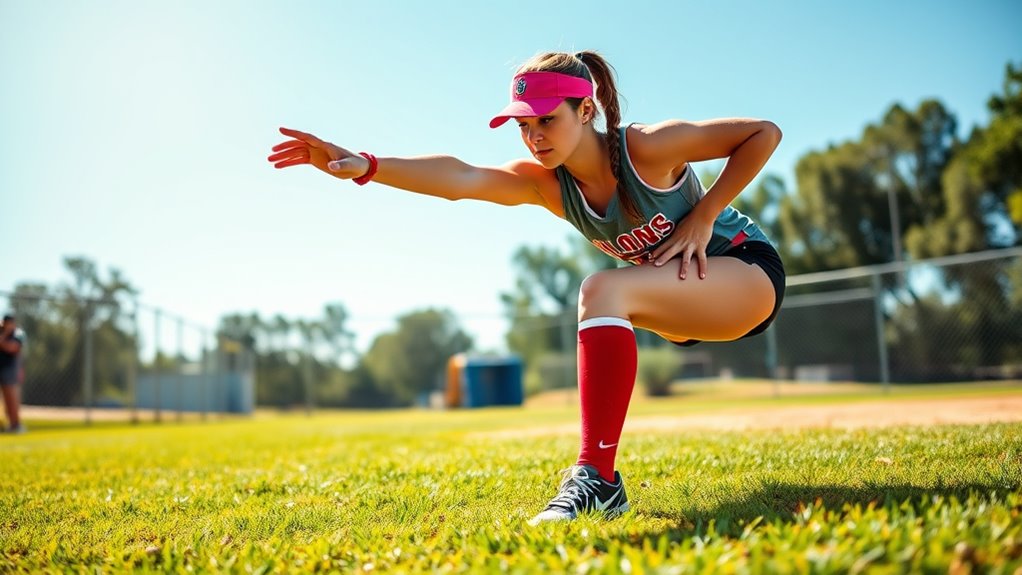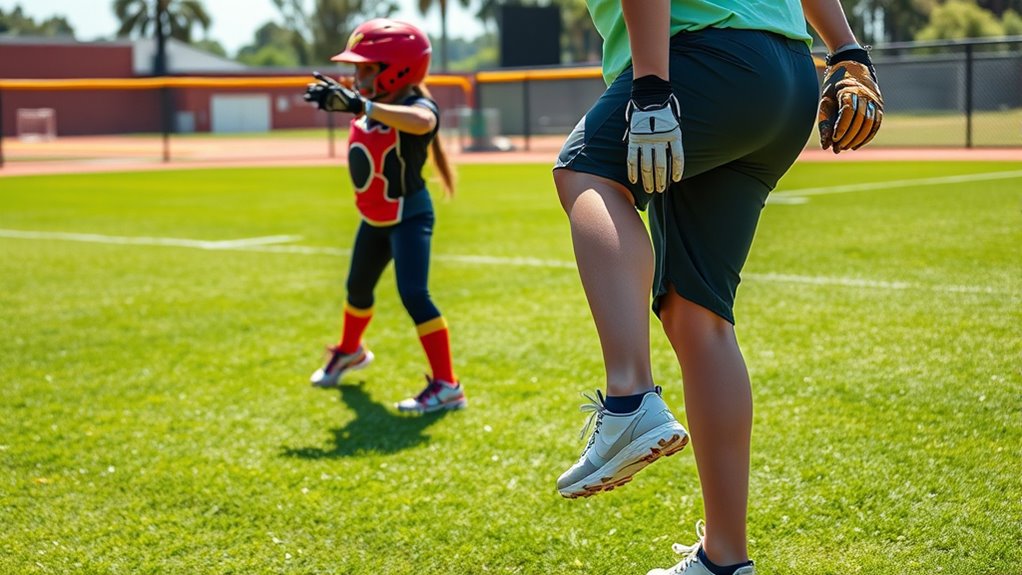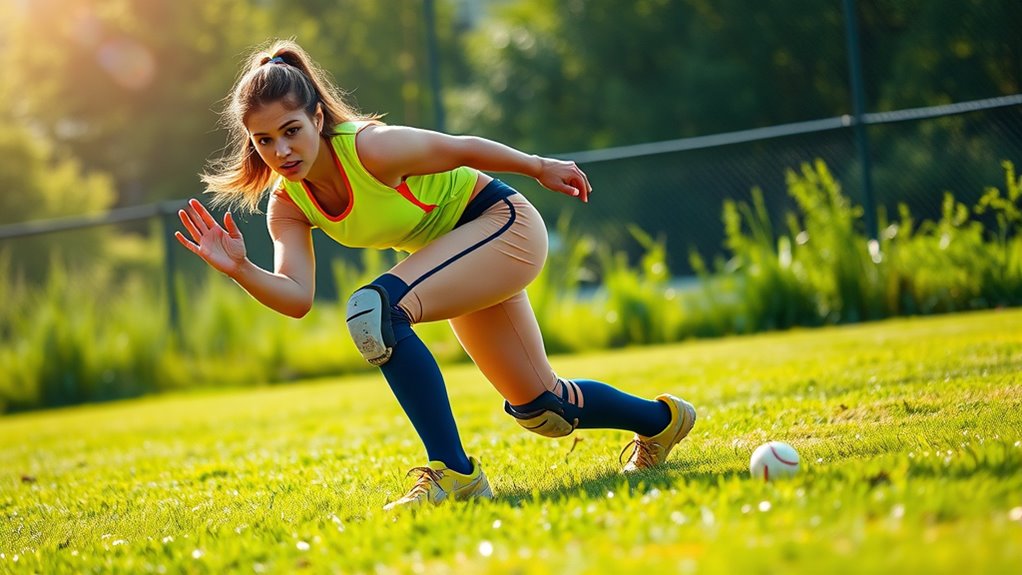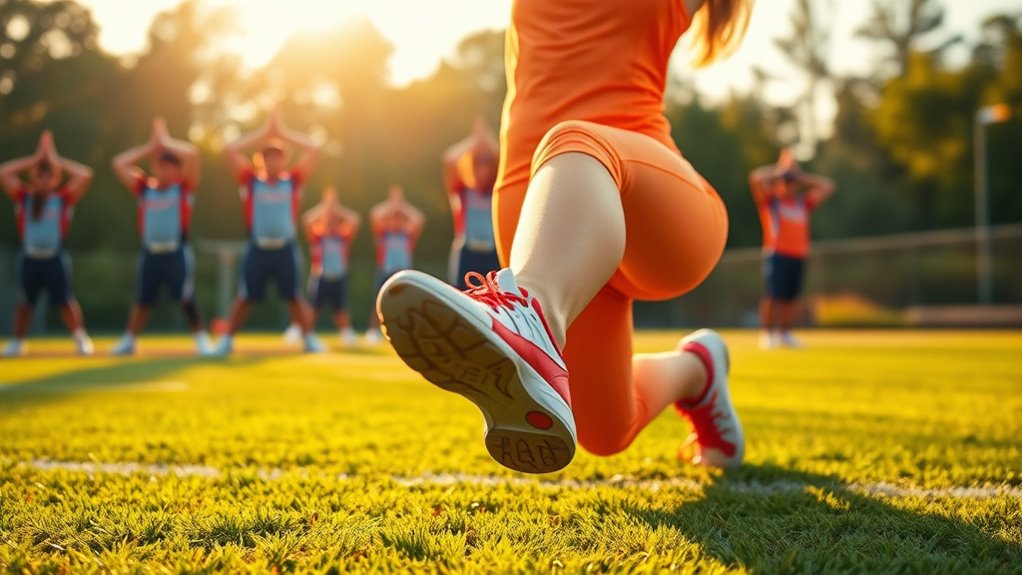To avoid common softball injuries, start with a proper warm-up that includes light jogging and dynamic stretches to activate muscles. Incorporate effective stretching—dynamic before play and static afterward—to improve flexibility. Use well-fitted equipment, maintain good technique, and stay hydrated with proper nutrition. Listen to your body to prevent fatigue and overexertion. Developing a personalized routine combining these elements helps keep you safe and ready—explore further to learn how all these steps work together.
Key Takeaways
- Perform dynamic warm-up exercises before playing to activate muscles and reduce injury risk.
- Incorporate targeted stretching, such as hamstring and shoulder stretches, to improve flexibility post-game or practice.
- Use properly fitted protective equipment and maintain correct technique during throws, catches, and slides.
- Strengthen core, legs, and rotational muscles to enhance stability and prevent overuse injuries.
- Monitor fatigue levels, stay hydrated, and rest adequately to avoid overexertion and strain-related injuries.
Recognizing Common Softball Injuries and Their Causes

Softball players are prone to a variety of injuries, often resulting from overuse, improper technique, or sudden impacts. Recognizing common softball injuries helps you prevent them. For example, shoulder injuries are frequent due to repetitive throwing, which can lead to rotator cuff strains or tendinitis. Knee and ankle sprains happen when you land awkwardly or twist during running or sliding. Wrist and hand injuries often occur from catching or hitting the ball improperly. Overuse injuries like tendinitis develop from repetitive motions without enough rest. Injury causes vary, but many stem from not using correct form, overexertion, or sudden impacts during play. Understanding these injury types and their causes helps you take proactive steps to stay safe on the field. Additionally, proper equipment and technique can significantly reduce the risk of injury during gameplay.
The Importance of Proper Warm-Up Before Playing

Warming up properly before stepping onto the field is essential to prevent injuries and enhance your performance. Incorporate pre game rituals that include light jogging, dynamic movements, and sport-specific drills to activate your muscles. A thorough warm-up increases blood flow, improves flexibility, and prepares your body for the demands of softball. This process also boosts injury awareness by helping you recognize any discomfort or tightness early on. Skipping warm-up routines can lead to strains, sprains, or pulls, so make it a priority before every game or practice. Remember, a good warm-up isn’t just about physical readiness; it sets your mental focus for the game ahead, reducing the risk of injury and giving you a competitive edge. Incorporating lifestyle habits such as adequate hydration and proper nutrition can also contribute to better overall readiness and injury prevention.
Effective Stretching Techniques to Improve Flexibility

Incorporating effective stretching techniques into your routine can substantially enhance your flexibility and reduce injury risk. To maximize benefits, focus on these methods:
- Dynamic stretching: Before playing, perform movements like leg swings or arm circles to warm up muscles actively, boosting blood flow and mobility.
- Static stretching: After games or practices, hold stretches such as hamstring or shoulder stretches for 20-30 seconds to improve flexibility and release tension.
- Combine both: Alternating dynamic and static stretches ensures your muscles are prepared and relaxed, decreasing strain during gameplay.
Strengthening Exercises to Support Softball Movements

Building strength through targeted exercises helps your muscles support the dynamic movements required in softball. Focus on core stability and balance exercises to prevent injuries and improve performance. Strengthening your core enhances your ability to generate power during swings and maintain control during throws. Balance exercises help stabilize your body during quick lateral movements and dives. Incorporate the following exercises regularly:
| Exercise | Focus Area | Benefits |
|---|---|---|
| Planks | Core stability | Improves posture and balance |
| Single-leg Balance | Balance exercises | Enhances stability and coordination |
| Russian Twists | Core and rotational strength | Boosts swing power and torso control |
| Side Plank | Core and lateral stability | Prevents side injuries |
| Dynamic stretching | Flexibility and mobility | Prepares muscles for quick movements and reduces injury risk |
Using Proper Equipment to Prevent Injury

Wearing the right protective gear can considerably reduce your risk of injury during games. Make sure your equipment fits properly and is in good condition to stay effective. Regularly check and maintain your gear to ensure it provides the best protection when you need it most. Additionally, understanding affiliate disclosures can help you make informed choices about purchasing quality equipment.
Protective Gear Effectiveness
Using the right protective gear is essential for reducing the risk of softball injuries. Properly fitted equipment ensures maximum protection and confidence on the field. For example, a well-fitting glove provides better control and reduces the chance of painful injuries. Ensuring your helmet fits snugly protects your head during fast pitches and batted balls, preventing serious injuries. Additionally, understanding the importance of necessary cookies helps improve user experience while maintaining safety measures. Here are three ways to maximize gear effectiveness:
- Check that your glove fit is secure, yet comfortable, so it doesn’t slip during play.
- Make sure your helmet fits properly, covering your forehead and staying stable at high speeds.
- Regularly inspect your gear for wear and tear, replacing items that no longer provide adequate protection.
Invest in proper fit and quality gear—your safety depends on it.
Equipment Maintenance Tips
Properly maintaining your softball equipment is essential for preventing injuries and ensuring peak performance. Regular equipment inspection helps identify damage or wear that could cause accidents. Ensure your gear fits properly; ill-fitting gloves, helmets, or bats increase injury risk. Replace worn-out or damaged items immediately to maintain safety standards. Check for cracks, tears, or looseness before each game. Proper gear fitting not only boosts comfort but also enhances control and safety. Use the following table as a quick reference:
| Equipment Type | Maintenance Tip |
|---|---|
| Helmet | Inspect for cracks, ensure snug fit |
| Bat | Check for dents, grip condition |
| Gloves | Replace worn-out padding |
| Catcher Gear | Confirm secure fit and integrity |
| Shoes | Replace worn soles, check laces |
Stay vigilant with equipment inspection and gear fitting to keep injuries at bay.
Techniques for Safe Throwing and Batting

To minimize the risk of injury, mastering safe throwing and batting techniques is essential. Proper baseball batting and softball pitching form protect your joints and muscles from strain. Focus on these key techniques:
- Keep your shoulders and hips aligned during throws to prevent shoulder injuries.
- Use your legs and core power for batting, avoiding overreliance on your arms.
- Follow through smoothly after each pitch or swing to reduce stress on your elbow and wrist.
- Practicing proper camping gear usage ensures safety and comfort during your activities.
Maintaining Good Fielding Form to Avoid Strains

Maintaining good fielding form is essential for preventing strains and injuries during gameplay. Your fielding stance should be balanced, with knees slightly bent and weight on the balls of your feet to stay agile. Proper glove positioning helps you catch the ball efficiently and reduces unnecessary strain on your arm and shoulder. Focus on staying low and moving smoothly rather than reaching or lunging, which can cause muscle pulls. Use the following table to fine-tune your technique:
| Aspect | Tip |
|---|---|
| Fielding stance | Keep knees bent, stay balanced |
| Glove positioning | Keep glove close to ground, ready to catch |
| Movement | Move smoothly, avoid lunging |
| Footwork | Stay on toes, quick lateral moves |
| Body alignment | Keep shoulders square and aligned |
Consistently practicing proper form helps prevent injuries and keeps you sharp on the field. Paying attention to proper technique can also improve overall performance and reduce the risk of overuse injuries.
Hydration and Nutrition Tips for Injury Prevention

Staying well-hydrated and fueling your body with the right nutrients can considerably reduce the risk of softball injuries. Proper hydration strategies prevent cramps and fatigue, keeping you sharp on the field. Nutrition planning ensures your muscles recover and stay strong, reducing strain and tearing. To optimize injury prevention, consider these tips: 1. Drink water consistently before, during, and after games to stay ahead of dehydration. 2. Incorporate electrolyte-rich drinks if you’re sweating heavily, especially in hot weather. 3. Eat balanced meals with lean proteins, complex carbs, and healthy fats to support muscle health and recovery. Monitoring AI safety measures in sports technology can also help develop better injury prevention tools and guidelines.
Listening to Your Body and Managing Fatigue

Listening to your body is essential for preventing softball injuries, especially when it signals signs of fatigue or discomfort. Muscle fatigue can decrease your strength and coordination, increasing the risk of strains or sprains. Pay attention to how your body feels during and after play—if you notice lingering soreness or weakness, it’s a sign to rest. Mental awareness is equally important; staying alert helps you recognize early signs of fatigue before they lead to injury. Managing fatigue involves taking regular breaks, staying hydrated, and avoiding overexertion. Trust your instincts—pushing through pain can worsen injuries. By actively listening to your body, you can adjust your intensity, prevent overuse injuries, and keep yourself safe on the field. Incorporating proper warm-up routines can also reduce the likelihood of injuries and improve overall performance.
Creating a Personalized Injury Prevention Routine

To prevent injuries, you need a routine tailored to your needs. Start by evaluating your flexibility, then include dynamic warm-ups before playing. Keep track of your progress to make adjustments that keep you safe and improving. Incorporating proper toilet maintenance practices can also help prevent unexpected disruptions during your routine.
Assess Individual Flexibility Needs
Understanding your individual flexibility needs is essential for creating an effective injury prevention routine. A thorough flexibility assessment helps identify tight muscles that could lead to strains or tears. Once you know your unique needs, you can develop personalized stretching that targets your specific limitations.
Here are three steps to get started:
- Perform a flexibility assessment to pinpoint tight areas and avoid unnecessary injury.
- Focus on personalized stretching routines that address your unique flexibility gaps.
- Track your progress regularly to adjust your routine and ensure continuous improvement.
Incorporate Dynamic Warm-Ups
Incorporating dynamic warm-ups into your routine is a crucial step in preventing softball injuries, as they prepare your muscles and joints for the physical demands of the game. Dynamic stretching involves active movements that mimic game actions, increasing blood flow and enhancing flexibility. Creating effective warm-up routines tailored to your needs helps you activate key muscle groups used in softball, such as shoulders, hips, and legs. Focus on activities like jogging, arm circles, leg swings, and lunges to get your body ready. By making dynamic warm-ups a regular part of your preparation, you reduce stiffness and improve your performance. Remember, a well-designed warm-up routine not only boosts your athletic ability but also considerably lowers injury risk.
Track Progress Regularly
Tracking your progress regularly is essential for creating an effective injury prevention routine because it helps you identify patterns and areas needing improvement. By monitoring your injury history and performance, you gain insight into what works and what doesn’t. This awareness empowers you to make targeted adjustments, reducing the risk of future injuries.
Here are three ways tracking progress can boost your safety:
- Spot recurring issues early, preventing minor problems from worsening.
- Celebrate small wins, motivating you to stay consistent.
- Tailor your routine based on your injury history, addressing specific vulnerabilities.
Stay committed to tracking progress; it’s your best tool for staying healthy and avoiding common softball injuries.
Frequently Asked Questions
How Often Should I Replace My Softball Equipment for Safety?
You should replace your softball equipment regularly to guarantee safety. Check your gear often through gear inspection, especially after heavy use or if it shows signs of wear. Equipment maintenance is key—replace gloves, bats, and helmets when they become damaged or outdated. Typically, helmets should be replaced every 1-2 years, and other gear annually or when you notice cracks or deterioration. Staying proactive keeps you safe on the field.
What Are Signs of Overtraining That Increase Injury Risk?
You should watch for warning signals of overtraining, like persistent muscle fatigue, soreness, or a decrease in performance. These signs indicate your body isn’t recovering properly, increasing your injury risk. If you notice these, take a break and rest. Pushing through muscle fatigue can lead to strains or other injuries, so listen to your body and prioritize recovery to stay safe and perform your best.
Can Specific Dietary Supplements Help Prevent Softball Injuries?
Think of dietary supplements as the supporting cast in your injury prevention story. While nutrition tips like eating balanced meals can help keep your body strong, supplements might boost your recovery and resilience. However, always prioritize supplement safety—consult with a healthcare professional before adding anything new. Supplements aren’t magic bullets; they work best alongside proper training, stretching, and hydration to keep you in the game and injury-free.
How Do Weather Conditions Affect Injury Prevention Strategies?
Weather impact and temperature considerations play a big role in injury prevention during softball. You should adjust your strategies based on conditions—hot weather increases dehydration risk, so stay hydrated and wear lightweight clothing. Cold temperatures can make muscles tight, raising strain injury chances, so warm up thoroughly. Rain or wet fields also increase slipping hazards, so check field conditions and wear appropriate shoes to stay safe.
What Mental Exercises Can Reduce Game-Time Injury Anxiety?
When nerves run high, you need to keep your cool and stay focused. You can do this with visualization techniques, imagining successful plays, and mindfulness exercises, like deep breathing, to calm your mind. These mental exercises help reduce game-time injury anxiety by grounding you in the present moment. Remember, a clear head leads to better decisions and safer play, so take a moment to breathe and visualize success before stepping onto the field.
Conclusion
By following these tips, you can greatly reduce your risk of softball injuries and stay in the game longer. Remember, nearly 60% of softball injuries happen during improper warm-ups or stretching, so don’t skip these essential steps. Staying proactive with proper technique, equipment, and listening to your body keeps you safe and ready for every play. Prioritize injury prevention, and you’ll enjoy the game while staying healthy and strong!









